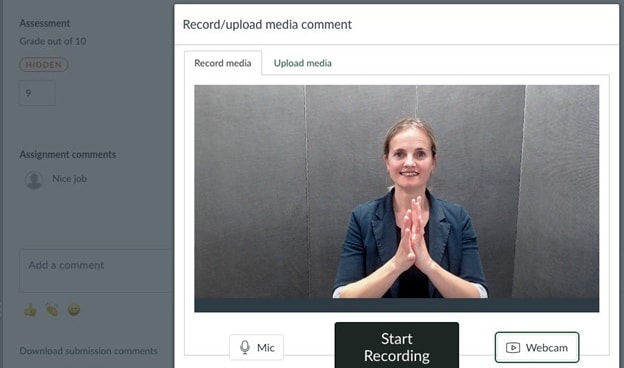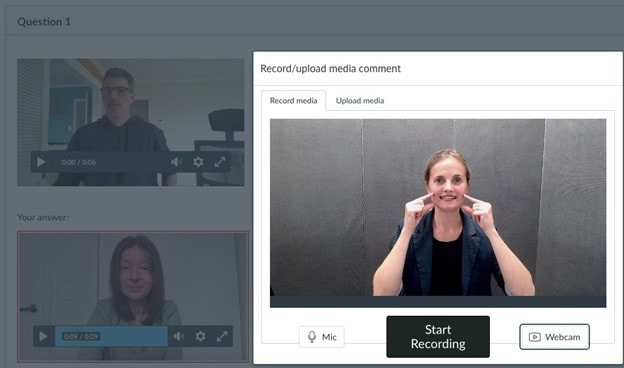In this case study Senior Lecturer (Teaching) Sara Pivac Alexander explains how and why she has adopted Canvas's Rich Content Editor (RCE) video feedback feature for formative tasks and quizzes in Canvas. Though this study was conducted in the School of Linguistics and Applied Language Studies, key learning points may apply to to any area where video feedback might be useful.
Subjects: Sara Pivac Alexander, Rachel McKee
Faculty: Humanities and Social Sciences but appropriate to all
Course: DEAF 803 School of Linguistics and Applied Language Studies
Subjects: Sara Pivac Alexander, Rachel McKee
Faculty: Humanities and Social Sciences but appropriate to all
Course: DEAF 803 School of Linguistics and Applied Language Studies
Technology/methods employed
Using the RCE to create video content, test question stimulus and provide feedback in the SpeedGrader on the Canvas site.
Why
The change in LMS and the greater video functionality within the Canvas RCE has allowed for smoother and more integrated use of video for NZ Sign Language (NZSL) test questions. In addition, with Canvas, Sara was able to add feedback as she was viewing students’ video submissions without needing to leave the Canvas marking page. Feedback and marking are done within SpeedGrader in a neatly contained space in the new Learning Management Systems (LMS). This was one of the functionalities lacking on BB. Something that Sara had previously wished for but had not been able to do on the previous LMS.
What
The effect will be to make Sara’s job easier when creating video content and giving feedback to students. The added functionality on Canvas will allow Sara to streamline and simplify the process of giving feedback and assigning grades. These tasks will take place within a single, self-contained system, reducing the need to juggle various video and grading tools while marking assignments.
How
Jessica Goodwin (FLaTA, CAD) trialed the use of video in Canvas before demonstrating the results to Sara and Rachel during the T3 course content migration from Blackboard to Canvas, for DEAF 803. Two training sessions were held showing Sara and Rachel the video functionality in Canvas. During these sessions, Jessica demonstrated video assignment submission, including video contributions on Canvas discussions. She also demonstrated how videos can be used by students and teachers alike in giving feedback as a form of peer review or through the SpeedGrader. When creating quizzes, there is also the option of using a video stimulus for quiz questions.
Sara found the RCE video tool easy to use and picked it up in no time.
Sara found the RCE video tool easy to use and picked it up in no time.
What are the key learning points?
- Assignments: Video assignment feedback can be recorded in the same webpage as where the grade is entered in SpeedGrader, streamlining two separate processes into a single place.
- Quizzes: Video can be used with/instead of written questions and instructions. Likewise, students can use the rich content editor to submit video responses to test questions. This may be widely applicable for decreasing breaches of academic integrity in assessments.
- Peer review and opportunities for students learning from each other via assignment peer review or discussion can be supported in video formats, just as they can by text for text assignments.
“Canvas is cool, as I can see my student’s video and SpeedGrader all on one screen.”
- Sara Pivac Alexander
“I love how I can give video-based feedback to students in Canvas, instead of writing in English. Useful for our New Zealand Sign Language courses!”
- Sara Pivac Alexander
“I love how I can give video-based feedback to students in Canvas, instead of writing in English. Useful for our New Zealand Sign Language courses!”
Useful information – links to publications or extra information about this area eg. Other research on topic.
- Alexander, Sara Pivac, et al. “E-Learning of New Zealand Sign Language: Evaluating Learners’ Perceptions and Practical Achievements.” New Zealand Studies in Applied Linguistics, vol. 23, no. 2, 2017, pp. 60–79, https://doi.org/10.3316/informit.264804545557001.
- David J. Nicol & Debra Macfarlane‐Dick (2006) Formative assessment and self‐regulated learning: a model and seven principles of good feedback practice, Studies in Higher Education, 31:2, 199-218, DOI: 10.1080/03075070600572090
- Mehmet Fatih Yiğit & Süleyman Sadi Seferoğlu (2021) Effect of video feedback on students’ feedback use in the online learning environment, Innovations in Education and Teaching International, DOI: 10.1080/14703297.2021.1966489
- Paige Mahoney, Susie Macfarlane & Rola Ajjawi (2019) A qualitative synthesis of video feedback in higher education, Teaching in Higher Education, 24:2, 157-179, DOI: 10.1080/13562517.2018.1471457




